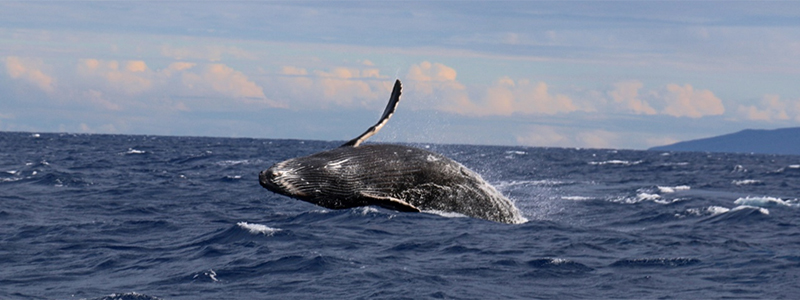The impacts to Marine Mammals from Underwater Noise
(by Dariya Garvish, Environmental Engineer at WKC)
The aquatic world is being increasingly compromised by an overwhelming array of human-caused noise. The sound of propellers, cavitation, seabed explosives, air guns, and military sonars cause stress and pose a threat to the overall survival of many marine mammals where communication is vital.
To the average human ear, sound signals below 20 Hz and above 20 kHz essentially “fall on deaf ears”. The spectrum of sounds and signals that are emitted and detected by marine mammals are in the much broader range of 7 Hz to 160 kHz.
Sound is vital to the survival of marine mammals and it is used for communication, orientation, feeding, mating, and detecting predator and prey. The sounds emitted from marine animals provide information about each other’s location, type of species, gender and where the mammal is coming from (Richardson et al., 1995).
One century ago, the marine ecosystem was not exposed to dredging, seismic surveys, oil exploration or many other highly impactful activities that have become widespread today. More and more navigational routes are being exploited by cargo ships, icebreakers, cruise liners and oil drilling companies. The number of ships in the world ocean has almost tripled from 1950 to 2000 (NRC, 2003), resulting in a 2 to 3 dB increase of low-frequency noise per decade (Mazzuca, 2001), on average.

During the mating season male species of Humpback whales are known to communicate by singing. These are the only whales known to exhibit this kind of behaviour. They sing low frequency, complicated songs repeated in patterns, which can last from a couple of minutes to half an hour or even longer (Perrin et al., 2009). Another peculiar ability of mammals such as dolphins is to use echolocation. It is the ability of the animals to orientate themselves by listening to the echo of the clicking sounds they make. This echo bounces off the objects in the water and based on this echo animals can identify the size, location, travelling speed and the shape of the object.
Excessive exposure to noise, which is a combination of intensity (loudness) and the duration of exposure to the noise, can lead to auditory damage in mammals. Auditory damage or disability results in reduced sensitivity to sound, meaning that the slightest sound that an aquatic species could hear prior to excessive exposure to noise, is no longer audible after exposure. The auditory damage and inability to detect the slight sounds can either be temporary, or irreversible, in case of increased of exposure to the noise (Popper et al., 2003).
Apart from the direct damage to the hearing ability of the mammals there are other concerns associated with the noise stress. It can disrupt the ability of the animals to detect the predators and prey, change their diving patterns and forging behaviour, and displace animals from their natural habitat. ’Auditory masking’ (Erbe et al., 2015) can occur when biologically important sounds can no longer be detected by the marine mammals because of the presence of another sound (masker) of the same loudness and frequency.
The Pacific Coast of Canada provides us with a real-life example of how underwater noise is disruptive for marine mammals. Only around 75 killer whales (Orcinus orca) remain in that area. Being aware of the potential noise issues, scientists conducted a research study and reported a correlation between local whales spending up to 25% less time feeding their offspring and exposure to boat noises in comparison to killer whales in empty waters. In addition, the salmon stock is also declining near the Pacific Coast, which is increasingly jeopardising the survival of whales.
The issue of noise pollution in relation to aquatic life is gaining momentum and is drawing the attention of the general public, NGOs, and authorities. In 2008 the European Union adopted the Marine Strategy Framework Directive aimed at achieving of “Good Environmental Status” in the European waters. One of the key pillars of this directive refers to underwater noise. In addition, the International Maritime Organisation, in pursuit of reducing carbon intensity of shipping sector, is regarding decrease of speed of the vessels as one of the viable options. In fact, the faster a vessel goes, the louder underwater noise it generates. In various places around the world it is highly recommended, and in certain instances it is a regulatory requirement, to carry out Marine Mammal and Reptile Observations (MMO) prior to commencement of any marine operation with potential noise impact.
WKC’s marine specialist are, for example, conducting MMO surveys as well as other marine ecology related work in the Arabian Gulf. We are proud to be contributing to the protection of our wonderful marine species including those marine mammals that are susceptible to the impacts of underwater noise and other human activities.
National Research Council 2003. Ocean Noise and Marine Mammals. The National Academies Press.
Mazzuca, L.L. 2001. Potential Effects of Low Frequency Sound (LFS) from Commercial
Vehicles on Large Whales. M.S. Thesis, University of Washington, 70 pp.
Richardson, G., Thomson M., 1995 “Marine Mammals and Noise”, Academic Press.
Perrin, W., Wuersig, B., Thewissen, J.G.M., 2009. “Encylopedis of Marine Mammals”, Academic Press.
Popper, A.N., Fewtrell, J., Smith, M.E. and McCauley, R.D. 2003/04, “Anthropogenic sound: Effects on the behavior and physiology of fishes.” Marine Technology Society Journal 37(4).
Erbe, C., Reichmuth C., Cunningham K., Lucke K., Dooling R., 2015 “Communication masking in marine mammals: A review and research strategy”. Marine Pollution Bulletin Vol.103, issue 1-2.


